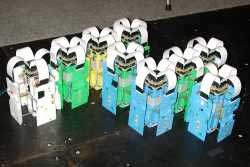This area deals with the fundamental laws and building blocks of nature and how they interact, the properties and the behavior of matter, and research into space and time and their structures.
innovations-report provides in-depth reports and articles on subjects such as astrophysics, laser technologies, nuclear, quantum, particle and solid-state physics, nanotechnologies, planetary research and findings (Mars, Venus) and developments related to the Hubble Telescope.

ESA’s Huygens probe, now orbiting Saturn on board the NASA/ESA/ASI Cassini spacecraft, is in good health and successfully passed its fifteenth ‘In-Flight Checkout’ on 14 September 2004.
This in-flight checkout procedure was the last but one planned before separation of the Huygens probe from Cassini in December this year, and it included some specific activities that were intended to prepare for the separation. The main difference in this procedure from previous checkouts was that

Fundamental questions that particle physicists have pondered for decades might be answered when a $9.2 million neutron physics beam line is built at the Department of Energy’s Spallation Neutron Source on Chestnut Ridge.
At the core of physicists’ excitement is the fact that the SNS will produce up to 100 times more neutrons than are produced by any comparable source in the world. Tapping in to those neutrons will be the Fundamental Neutron Physics beam line, which will he

A University of California scientist working at Los Alamos National Laboratory and researchers from Northrop Grumman Space Technology have developed a novel method for generating electrical power for deep-space travel using sound waves. The traveling-wave thermoacoustic electric generator has the potential to power space probes to the furthest reaches of the Universe.
In research reported in a recent issue of the journal Applied Physics Letters, Laboratory scientist Scott Backhaus an

It started with tennis balls. As a former collegiate tennis player, Daniela Rus habitually rolls two tennis balls around in her hand as she paces her office. As a robotics researcher at Dartmouth College, she wondered why the tennis balls shouldn’t be able to roll themselves around.
She soon determined that electromagnets didn’t have enough lifting power to solve the tennis-ball problem. However, her question led to a decade-long research program into the challenges of designing robot

Dedication Ceremony in Tucson, Ariz., Will Unveil the World’s Most Powerful Ground-Based Telescope to an International Audience
The LBT Corporation announced today that the dedication ceremonies for the Large Binocular Telescope (LBT) will be held Oct. 15. This scientific achievement will be marked by a formal dedication dinner for partners and their guests. The media is invited to attend tours of the LBT and Arizona astronomy facilities in advance of the dedication.
T

A simplified design for ultra-sensitive X-ray detectors offering more precise materials analysis has been demonstrated at the National Institute of Standards and Technology (NIST). The advance is a step toward making such devices cheaper and easier to produce. Users may eventually include the semiconductor industry, which needs better X-ray detectors to identify and distinguish between nanoscale contaminant particles on silicon wafers.
The new design, described in the Sept. 13 issue of App